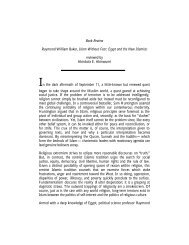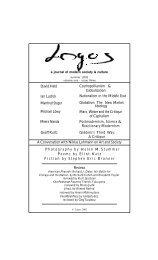Michael J. Thompson Stephen Eric Bronner Wadood Hamad - Logos
Michael J. Thompson Stephen Eric Bronner Wadood Hamad - Logos
Michael J. Thompson Stephen Eric Bronner Wadood Hamad - Logos
Create successful ePaper yourself
Turn your PDF publications into a flip-book with our unique Google optimized e-Paper software.
Stanley Aronowitz<br />
Mills borrows concepts such as “élite” from eminent forebears, he refuses the<br />
hierarchical thinking that informed the writings of theorists such as Mosca and<br />
Pareto. For example, he invests new significance to it in the process of<br />
investigating historically-situated élites. As a result, the labor union élite and<br />
the power (ruling) élite display different characteristics, although in The New<br />
Men of Power we can see the first pass at the development of a new theory<br />
His main theoretical project, explicated most fully in Character and Social<br />
Structure, was to situate the biographies of leading economic and political<br />
actors—labor leaders, the main figures in business, military and political<br />
institutions—within the social structure and the spatio-temporal context<br />
which set the limits and provided the opportunities for their activity. This<br />
methodological imperative is designed to account for individual variation of<br />
broad types, but also demonstrate the degree to which the social structure—<br />
explicitly named in terms of key institutional orders sets, at a specific time and<br />
specific place, the limits as well as the opportunities for individual and group<br />
action. Thus, our biographies mediate, and are mediated by, the institutional<br />
frameworks which condition decision-making. While, except in White Collar<br />
Mills is interested mainly in describing and explaining the structure of power,<br />
rather than of the worlds of the relatively powerless, this work is always<br />
undertaken in the interest of reconstructing a democratic public.<br />
we shall use this term psychic structure (emphasis in the<br />
original) to refer to man conceived as an integration of<br />
perception, emotion, and impulse. Of course there are other<br />
psychic functions, memory and imagination for example, but<br />
we shall limit our terms at this point. For our purpose,<br />
“psychic structure” will refer to when, how and why man feels,<br />
perceives and wills.<br />
At the core of Gerth and Mills’s theory are the concepts of “institution” and<br />
“self.” The notion of institutional order connotes the complex of institutions<br />
which, taken together, constitute what we loosely designate as the structure of<br />
power in “society,” chiefly the political, economic and military orders. Thus<br />
conceived the character structure of individuals formed by physical, and social<br />
conditions, particularly those of childhood biography, including family and<br />
schooling prepares them for playing certain “roles” within the institutional<br />
<strong>Logos</strong> 2.3 – Summer 2003




